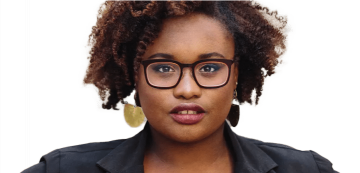What are the key differences between “doing no harm” and being anti-racist in the workplace?
Lily Zheng: So for me, doing no harm requires acknowledging that the world around us is actively harmful through racism, sexism, etc. I see “doing no harm” as a radical act, so for a company that means interrupting the inequities of the world. It ensures that your company is okay and is not “one of the bad ones.” An anti-racist company, by comparison, goes a step further to dismantle the inequities of the world. It’s a commitment to not only be the eye in a global storm but also to ending racism everywhere. That is the distinction between the two.
Alexandria Noel Butler: I agree with Lily, but I also want to address this from a people to people perspective. If you talk to people of color in white spaces, you will find out that many of us are not experiencing active racism from our company on a day to day basis, but rather we're receiving active racism from the people that we work with every single day.
For a manager, “doing no harm” is being aware that because I am a black woman I may experience certain behavior in the workplace, yet doing nothing to help or change that. If a manager sees this type of behavior or knows it’s going on but does not defend me or protect me, that will really affect our manager-employee relationship. Now, we have a racist relationship. That manager has decided, “Well, I’m not racist. I didn’t say those things, so I didn’t do any harm.” They’re aware that other people are saying or doing things that are actively micro-aggressive or racist, aware that this affecting my performance in my day to day life, and still taking no action. That’s what “no harm” looks like to me from a day-to-day perspective.
Dominique Hollins: Inaction is an action. By doing nothing, you are perpetuating racist behavior and become a part of the problem.
Karen Fleshman: To me, an anti-racist workplace extends beyond what is going on within the four walls of a company. It goes to literally every aspect of the company's operations—from what it produces, what vendors it uses, how it shows up for the community, what they’re investing in, and the company’s origins. Many, many companies were founded on the profits of slavery.
When I think of an anti-racist workplace, I want companies to produce a report that outlines: this is how our company has profited from racism, this is who works here, this how much they're compensated, and what their levels are. And then, I want companies to share their plan of what they’re going to do to change this. I want them to create a group of stakeholders, including both internal and external people, who will hold the company accountable and be transparent and public throughout the entire process to transform it into an anti-racist company.
What does it look like in action to “do no harm” and be “anti-racist” when it comes to recruiting and hiring?
Lily Zheng: I see “doing no harm” as being just good enough. The goal of “doing no harm” with recruitment and hiring for most companies looks like creating a talent pool that reflects the pipeline and hiring a workforce that reflects the talent pool. And usually, they do this by reaching out to universities and other programs to supplement their usual recruiting processes to make sure that things are fair. They also might train their hiring managers on unconscious bias to make sure that they're being fair. Fairness is a big focus of “doing no harm.”
Now, this is very intensely contrasted with what I understand an anti-racism company to be. An anti-racist company’s goal isn't just to create a talent pool that reflects the pipeline but to reimagine and create a better pipeline and a better process to hire a workforce that reflects the world. They achieve that goal by going above and beyond what most companies would consider is good enough. They might create partnerships with the local community, they might create core skills and competencies that reflect a vision for a more just future and then hire for it. They envision what an anti-racist world would look like and then, working backward, create the recruiting and hiring processes needed to get there.
We need to be very, very clear about what the core skills and competencies for an anti-racist org would look like and what we won't tolerate. You aren’t an anti-racist organization if white supremacists don’t hate you. If that's the case, you're not anti-racist enough - work harder.
Jared Karol: Change can start with recruiters. Many hiring managers are demanding, they want candidates yesterday and don’t want to wait. Instead of saying, “Yes sir - sorry, we'll get you those three white men on the slate,” you must learn how to be more influential and committed to having important conversations with them. It’s hard work because people above you are pressuring you, but you need to stand up say, “I get it. We're all under stress. But I need two more weeks to get you who I think should be on this candidate slate.” Recruiters need to own the beginning of the hiring process. If they don't stand up and take action, then the existing system will just stay the same.
Alexandria Noel Butler: Another note for recruiters and hiring managers: y'all need to fix these job descriptions. Most of the time, applicants actually don't need to do 60-70% of what's in the job description to do that job well. Hiring managers and recruiters need to really figure out what skills and experience a candidate needs in order to perform this job successfully. Studies show that even if they have only two of the ten skills needed, white men will always apply for a job. On the other hand, a black woman like myself knows that if there are ten bullet points on a job description, I have to have twenty when in actual fact there are only five bullet points that are needed to be successful in this role. To build an anti-racist workplace, you need job descriptions that attract diverse people.
Karen Fleshman: I would add in addition to reassessing the job requirements, we should also reassess the qualifications. For example, does this role really require a Bachelor's degree? That requirement in itself is going to eliminate a lot of qualified folks from your hiring process.
Dominique Hollins: You don't have to wait for your organization to do it. I must preface this by saying your organization may not be ready, but you can get them ready. You are now the agent of change. Right now, many of your organizations are leaning on a handful of people of color and these people are overwhelmed. They need your support. While your company is busy trying to figure it out, you can take initiative and build the infrastructure now. That way, once your company catches up to you, you can say "here's the work we've already done, let’s carry it forward." Be the change you want to see and when everyone else catches up, they will follow you.
What are the “do no harm” and an “anti-racist” approachs to employee growth and development?
Alexandria Noel Butler: Being anti-racist starts with having a manager who shares areas of growth opportunities with their employee from day one; someone who actively puts a development plan together and encourages their employees to improve their skills. Being an anti-racist manager, to me, is this continued effort to be fair with your team. That stems from being transparent and effective in weekly one-on-ones, going beyond discussing the status of your work to address what do you need from me as your manager? How can I make this a better working relationship? How are we getting you to your goals? You say you want to be promoted next year, so what are we doing right now to make that a reality.
Dominique Hollins: That's an excellent example of “people don't leave companies, they leave managers” and those types of conversations do not always take place. It's a developmental problem. There are a ton of managers that simply don't know how to have those conversations - they don't care.
Karen Fleshman: One of the times when my phone rings off the hook is at annual review time. So many women of color, in particular, get these performance reviews with feedback they have never received in person—and a lot of it is very intensely personal. This is going to affect their compensation and their ability to get promoted because they've never seen or heard this feedback before. If you’re a manager and you feel uncomfortable sharing feedback with a direct report, so you withhold it and then just spring it on her during the annual review process, you are undermining that employee’s ability to grow. It's on you as a manager to overcome whatever is making you feel uncomfortable giving one employee that feedback so all your direct reports have the opportunity to grow.
Lily Zheng: I want us to come away from this conversation thinking, “How can I get my company to create decent managers by default?” - and that gets into really tough conversations about how do you train, promote, and select your managers.
Dominique Hollins: Another tangible example is succession planning. If your team looks the same this year as it did the year before, it's probably going to look the same next year. Your succession plan should know what the future of your company will look like. If you know where the trajectory of your sales and your customers are headed, your leadership team should reflect those customers.
Last, but certainly not least, there is the issue of pay equity. There's always time to review the salaries of your employees to ensure that they are being paid at the market rate. It may be expensive now, but it's even more expensive when they leave. So I'm going to encourage you to do a pay equity review and make sure that everyone who was paid their worth, should be. That is active anti-racism—identifying a problem, making a commitment to change it, and then taking action.
What are characteristics of a “do no harm” and an “anti-racist” leader? How do they differ?
Lily Zheng: Leadership that “does no harm” will commit to diversifying your company and say the right things. Leaders that are anti-racist will tie the diversification of their company into their bonuses and their salary. They are willing to take a hit if they fail. That's the difference.
Jared Karol: A “do no harm” leader maybe supports an ERG, speaks at a D&I event - but it's performative. An anti-racist actually makes the commitments that that Lily, Karen, and others have been saying. It actually risks his—and it usually is a him— social, professional, and career capital, because he believes in holding himself accountable.
Dominique Hollins: A leader and an executive that “does no harm” are just checking the box. They are hoping to do the fastest thing possible in order to stop getting bad press. They want immediate actions that get bad PR to stop, but they're not considering the impact of their actions and they’re not looking at the long-term strategy. That's a “do no harm” leader. In some ways, they're harmful and we need to get them out of the way.
An anti-racist leader that will not only make a commitment but they also follow through with accountability. If you're the CEO and your Chief Diversity Officer or diversity leader does not have a quarterly update meeting to show you progress, then there is no scorecard of accountability. If that's the case, you don't have an anti-racist leader, you are just checking a box. You'll know if your company is just checking a box because it'll reflect on the leadership team and it'll start to show up in how you build your product.
Live Q&A:
What metrics should companies use to measure DEIB initiatives?
Alexandria Noel Butler: I used to work for Airbnb back when it was a very, very tiny startup. The company really stood by building a sense of belonging, but we all felt like no one was going to act on that value. The CEO at the time, Belinda Johnson, came up with this wonderful idea to tie that value to our performance review. Every employee had to fill out a review card with their strengths, areas of opportunity, and a new section where you had to give examples of how your work contributed to the belonging mission of Airbnb. It was literally tied to your review as an individual. Reviews went from being solely focused on performance and goals to evaluating how we were actually driving this mission of diversity and equity, and belonging forward. If you tried to skip that portion of the review, you just couldn't submit. It held everyone accountable and it was our commitment to do something to make the people you work with feel they belonged.
Dominique Hollins: The metrics changed by level, so the metrics for the board of directors are going to be different from the metrics for the C-suite and for managers and for individual contributors. What I recommend is that you build each level based on their degree of influence and establish quantifiable actions. For example, for individual contributors that might be joining an ERG's or signing up to participate in D&I training sessions.
Lily Zheng: I take a slightly different approach to metrics. The most successful companies I’ve seen have shifted from focusing on what individual employees can do to make someone in the office feel belonging to understanding how D&I relates to their employees’ daily jobs. These companies ask how they can actually push forward D&I through what they're doing, let's say in marketing, sales, engineering, product, etc. to make an impact. What I found works really well with taking that approach is that you create so much more buy-in, because suddenly, everyone can see exactly how D&I relates to their work.
For example, rather than asking, “Did you build belonging for a diverse person in the office?,” you can then ask, “Does our product now resonate more with underserved or underrepresented populations?” And guess what, we already have metrics around that and the metrics are not going to lie. We can see and measure the impact through the work that you've done. This approach is simultaneously more impactful and takes the individual resentment out of it.
How can an entry-level employee drive change within an organization?
Jared Karol: Take the time to build relationships. Make it very clear what you care about and what you want to learn, so people know, “Oh, this is a person who cares about this.”
Alexandria Noel Butler: I'm gonna say something slightly controversial, which is: be good at your job. And I think that we don't talk about that enough. I'm always telling entry-level folks, first and foremost, we need to make sure that you're good at your job. Learn your job well because your quality of work will shine and it will give you more influence and power in these spaces. Senior leadership is not going to align themselves with someone that has great ideas, but their work product is whack. You need to have both. I want to make sure that when you speak, there is an imaginary microphone - everyone turns around and says, “do what she said.” Part of building that microphone is being great at what you do.
Dominique Hollins: I would just throw on there: be a sponge. Not only are you doing what they hired you for, but you need to understand the ecosystem that you have entered. You need to watch things before you start making recommendations. If you weren’t hired for D&I, you don't want to be the D&I person in the room right off the bat. Start by doing your job well, and then develop insights that where I D&I can be a tool to advance that goal.
Do you have tips for telling a “do no harm” manager that their hands-off approach makes me feel alone and vulnerable without experiencing repercussions?
Lily Zheng: Your ability to give feedback upwards to your manager without repercussions is dependent on psychological safety. If you don't feel psychologically safe with your manager, no tip that we can give you will assure an outcome that doesn't involve you being retaliated against. Knowing that, please get another manager. That's the only advice that I can share 100% and feel very good about. It's really tough when our managers don't get it, and when our managers don't create those environments that are safe for us to give feedback, but please don't feel like you are responsible for that. What you can do is get out, and if you can't get out, take care of yourself.
Jared Karol: I don't know how familiar you are with nonviolent communication, but the concept is being really clear about what you need from a relationship. It's a little scary because it makes you vulnerable, but you sit someone down and say, “here's what I need, and here's why,” and then wait for him or her to respond. They might fumble, they might not have a satisfactory answer, but you're collecting data in a way. Does this person have the relationship skills and the commitment to me to have this conversation and to move things forward? And they may or may not, but it's kind of sussing them out to see. Maybe there's something that they haven't shown you that could help recover your relationship.
Karen Fleshman: There are people who are active harm agents in the workplace and then there are folks who are just inexperienced and lack self-awareness. If you can approach them and say, “Hey, this is what I'm experiencing right now. I'm bringing this up because I care about you and I want to have a really productive work experience. This is what needs to change in order for me to do that.” I think that kind of tone of conversation can be very productive if this person is just lacking self-awareness and is not actively engaged in causing you harm.
Alexandria Noel Butler: Once you figure out what category your manager sits in, use data. Don’t go to your manager and say, “You make me feel X and I don't feel comfortable being vulnerable.” If they don’t have an emotional IQ, they don't know what that word means. That conversation will just go over their head and irritate them because you're asking for things and they just don't know how to respond.
Try approaching the conversation with one specific example, like, “it’s very clear that we had a disconnect on this project and I would love to talk to you about that so we can both be better and grow.” If your manager is results-oriented and you're coming to them saying “how do we make this specific thing better,” they may be more open. Use that as a lifeline until you get a new job.
















